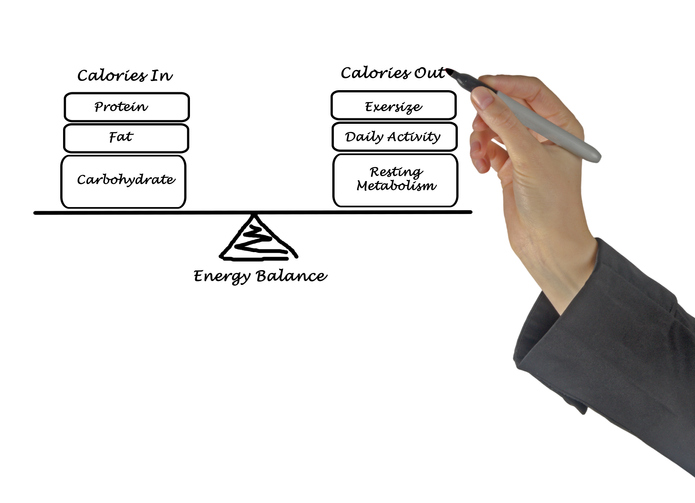 Resting metabolic rate is the energy your body uses to perform the most basic functions, at rest, for a 24-hour period. This can also be termed the resting energy expenditure. Total metabolic output is the total energy expenditure you use throughout the day which includes your resting energy expenditure and then energy expended doing all of the other activities you do. The turnover of this energy is often referred to as the metabolic rate.
Resting metabolic rate is the energy your body uses to perform the most basic functions, at rest, for a 24-hour period. This can also be termed the resting energy expenditure. Total metabolic output is the total energy expenditure you use throughout the day which includes your resting energy expenditure and then energy expended doing all of the other activities you do. The turnover of this energy is often referred to as the metabolic rate.
To understand resting metabolic rate, we must understand how our body uses energy, why we eat, and how the body uses the food we eat to regenerate energy. This is in fact metabolism.
Let me explain!
For any function to happen in the body, the body uses a chemical energy called ATP (Adenosine Tri Phosphate) to convert to mechanical work. Unfortunately, we only store about 2 seconds’ worth of this in every cell. A simplistic (non-scientific) explanation is that any cellular structure in our body requiring more than 2 seconds’ work, must continually re-make ATP.
There are 4 big users of this energy in the body. There is the nervous system, muscle, our internal organs and the process of digestion. These functions happen, every day, all day. Energy must be turned over and then replaced through the food we eat. The 3 food groups we eat that provide the chemicals to regenerate our ATP are carbohydrate, fat and protein. These all supply the chemical reactions to keep this energy ATP re-generated in the body. This is a very complex process calledmetabolism. The amount our body uses in a 24-hour period just to stay alive is referred to as resting metabolism or basal metabolism.
Above the resting metabolism use, we can add the energy used every day in everything else we do, such as moving, exercising, eating, repairing, thinking and just generally living. This would be you your total daily metabolism or total daily energy expenditure. We can measure this in the total kilocalories (calories) needed each day to feed the system. The more metabolically active structures you have on your body that use energy i.e. muscle, the more resting metabolism you will use and the more you will use in movement and tasks throughout the day. Body composition is key to resting metabolic rate and total energy expenditure as muscle is metabolically active all the time.
The process of generating and using this energy gives off a by-product of heat, carbon dioxide and water. We can measure the heat that is given off in the use of energy. The heat is measured in Kilocalories (just referred to as a calorie by most of us). A kilocalorie is enough heat to raise 1g of water 1° centigrade. That is how it is measured and why we can balance calories in with calories out. This turnover of energy by the body is what is our metabolism. We want to use up as many calories as we can every day, being metabolically active, and eating the right amount and balance of calories to match that. Any calories eaten, not used, will be stored. Of course, we all know what that means. Some extra fat going on. The optimum is to become a metabolic furnace where your body burns a high amount of energy at rest and is efficiently using the fuel you eat every day to run itself. If we don’t, we will store more fat which will lead to health issues.
As the energy turnover uses oxygen to metabolise we can measure the rate at which our body turns over that energy at rest. This will tell us whether the body is working effectively and efficiently and burning the fuel we feed it every day. We can also measure how much muscle you have, relative to how much fat you have. We measure the resting metabolic rate (kilocalories needed at rest) by analysing the inspired and expired oxygen in a lying 15 min test. We can do this with a gas analysis RMR test. We can assess your body composition using a bio-electrical impedance test. This measure fat against muscle in the body. However, this isn’t convenient for most people unless you are in a clinic such as ours. You can estimate your energy expenditures using formulas’ that have been calculated as below.
There are several factors that affect resting metabolic rate so it is well worth having a test to see if your metabolism is decreasing in efficiency. Some of the factors that affect it are.
- Age
- Gender
- Efficiency of the muscle fibres
- How much muscle fibre we have
- Body weight/mass
- Height
- Movement
- Fitness levels
- Diet
 By calculating your resting metabolic rate (resting energy expenditure) you can then add your physical activity energy and see how many calories you need per day. If you want to lose weight/body fat it is recommended to cause a 500-calorie deficit per day to lose approximately 1lb per week of body fat. You can do this by upping your output with movement or lovering your input through lowering calories. Rule of thumb is never to go lower than your resting energy expenditure in food calories as this will put the body into trauma. Much better to do a bit of both. Drop some food calories and up your output of energy by moving more.
By calculating your resting metabolic rate (resting energy expenditure) you can then add your physical activity energy and see how many calories you need per day. If you want to lose weight/body fat it is recommended to cause a 500-calorie deficit per day to lose approximately 1lb per week of body fat. You can do this by upping your output with movement or lovering your input through lowering calories. Rule of thumb is never to go lower than your resting energy expenditure in food calories as this will put the body into trauma. Much better to do a bit of both. Drop some food calories and up your output of energy by moving more.
You can work your energy expenditure out but using either the second example below which is the simplistic formulae, or you can use the more scientific Harris Benedict Equation which takes into account more of the factors that affect metabolism and total energy expenditure.
Give it a go. If you get stuck the give us a shout on admin@drummondeducation.com.
Example 1 (The scientific one)
The Harris Benedict Formula
This is a calorie formula using the factors of height, weight, age, and sex to determine basal metabolic rate (BMR). This makes it more accurate than determining calorie needs based on total bodyweight alone. The only variable it does not take into consideration is the amount of lean body mass. Therefore the equation will be very accurate in all but the extremely muscular (it will underestimate caloric needs) and the extremely over fat (it will over estimate caloric needs).
Men: BMR = 66 + (13.7 x weight in kg) + (5 x height in cm) – (6.8 x age)
Women: BMR = 655 + (9.6 x weight in kg) + (1.8 x height in cm) – (4.7 x age)
Note:1 inch = 2.54 cm
1 kg = 2.2 lbs
1 stone = 14 lbs
Example:
You are female
You are 30 yrs old
You are 5’ 6” tall (167.6 cm)
You weigh 8 stone 8 lbs (54.5 kg)
YourBMR= 655 + 523 + 302 – 141 = 1339 calories/day
Now that you know your BMR, you can calculate ‘Total Daily Energy Expenditure’ (TDEE) by multiplying your BMR by your activity multiplier from the chart below:
Activity Multiplier
Sedentary BMR x 1.2 (little or no exercise, desk job)
Lightly activeBMR x 1.375(light exercise/sports 1-3 days/week)
Mod. Active BMR x 1.55 (moderate exercise/sports 3-5 days/week)
Very Active BMR x 1.725(hard exercise/sports 6-7 days/week)
Extra Active BMR x 1.9 (hard daily exercise/sports & physical job)
You can also choose numbers between.
Example:
As above BMR is 1339 calories/day
Your activity level is moderately active (work out 3 – 4 times a week)
Your activity factor is 1.55
Your TDEE = 1.55 x 1339 = 2075 calories/daily
Example 2 (The easy way)
BMR Rough Estimate
Men = Weight in Kg x 24 calories
Women = Weight in Kg x 22 calories
Then choose your activity factor from the above and multiply your resting figure by your total daily energy expenditure (TDEE)
If you would like to know more about nutrition and energy expenditure why not join us on our nutrition for exercise and health course.
